Wash Stations
Data Sheet
![]() Shop this product in our online store
Shop this product in our online store
Products - Microarray Tools - Wash Stations - Microarray Wash Stations to Speed and Simply Blocking, Wash and Rinse Buffer Steps for DNA and Protein Microarrays

Arrayit Microarray Wash Station accommodates up to 6 standard glass substrate slides, fits neatly into a 500 ml beaker, and is used in conjunction with a magnetic stir bar and stir plate for efficient processing and washing of microarrays prior to hybridization and scanning. Use the ArrayIt® Microarray Wash Station for a wide spectrum of DNA and protein microarray applications.
Advantages of the Microarray Wash Station
- Allows free flow of buffers to wash 25 x 76 mm glass substrate slides
- Constructed of chemically resistant composite
- Fits neatly inside a 600 ml beaker
- Rugged design ensures durability
- Holds 1-6 standard glass microarrays
Short Protocol
1. Fill beaker with 500 ml of wash buffer A and stir bar.
2. Insert the Microarray Wash Station into Beaker.
3. Insert Slides into Wash Station.
4. Wash briefly...only until cover slips fall off.
5. Immediately transfer to new beaker filled with 500 ml of wash buffer A and stir bar.
6. Wash 5 minutes on stir plate.
7. Transfer Microarray Wash Station and Slides to beaker with 500 ml of wash buffer C.
8. Wash 5 minutes on stir plate.
9. Dry in a microarray centrifuge and Scan.
Recommended Equipment and Reagents
NanoPrint™ 2 Microarrayers
SpotBot® 4 Personal Microarrays
ArrayIt® InnoScan 710 Laser Scanners
Hybridization Cassettes
Microarray Centrifuge
Hyb Cassettes 1x24 and 1x16
Wash Buffers A-C and 1-3
Microarray Slide Substrates
Products - Wash Stations and Trays - Microarray Wash Trays to Accelerate Blocking, Wash and Rinse Steps for Glass Substrate Slide DNA and Protein Microarrays
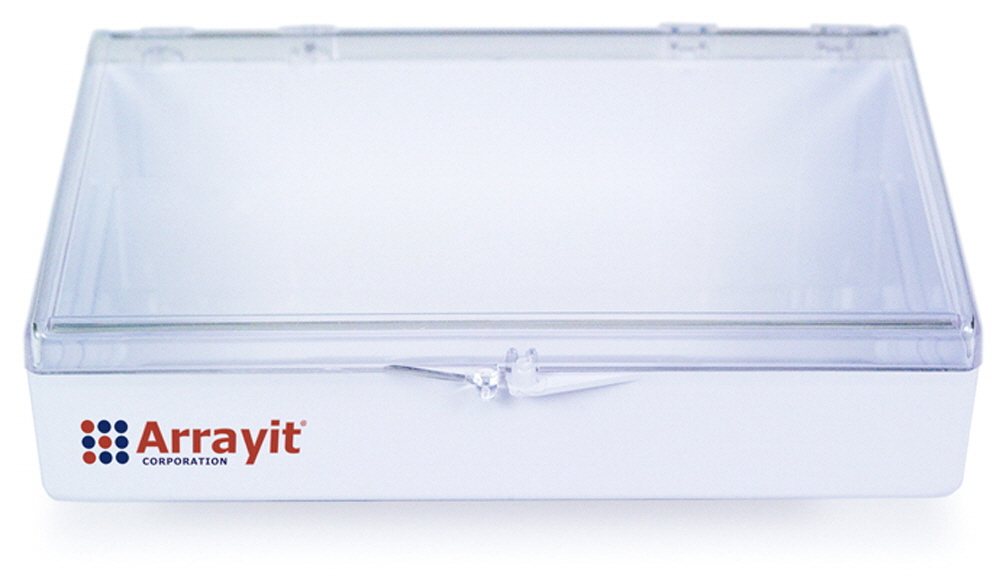
Arrayit offers affordable, durable and and easy to use injection molded plastic trays with lids for microplate-formatted microarray processing and washing. Microarray Wash Trays accommodate microarray reaction hardware with a 4 glass substrate slide capacity including Arrayit AHC4x24, AHC4x16, AHC4x8, and MMH96 reaction tools. Trays are compatible with Arrayit’s complete line of DNA and protein microarray blocking and wash buffers as well as buffers containing light solvents, and these tools are indispensible for microarray laboratories using glass slides from Arrayit, Agilent, Roche NimbleGen and other suppliers.

Figure 1. Base of reaction tool filled with 4 slides, and 100 ml of buffer. This container sits on your favorite shaker to create agitation for washing microarrays slides.

Figure 2. AHC4x24 Hybrdization Cassette which enables 96 microarrays, 24 microarrays per slide substrate. See the tools section of our website for other hybridization cassettes compatible with this container. These reaction tools and Array Plate hybridization station are sold separately.
Protocol
Arrayit Microarray Wash Trays are most useful after a set of hybridizations or incubations are completed on the Array Plate Hybridization Station using a plate-based multi-well hybridization cassette.
1. Expel hybridization reaction from all the wells first and immediately proceed to remove top of the reaction casssette lid in a large volume of wash buffer designed for your assay.
2. Typically 3 or more washes are required after each reaction, therefore have 1 tray setup for each of the buffers you want to use, so you can quickly transfer the microarrays on the base between each buffer. Use ~100 ml of buffer. Put the tray on a shaker to provide agitation that will provide a very homogenous wash across all the microarrays on the slide substrates. The microarrays stay in the base of the tool.
3. After washes are complete, remove microarrays 1 at a from the base of the reaction tool and dry in a Microarray Centrifuge. If more reactions are requried, have a second clean and dry microarray hybridization cassette of the same format ready to load directly after drying the microarrays for subsequent hybridization, binding or detection reactions.
Products - Microarray Tools - Microarray Wash Stations - High-Throughput Wash Station
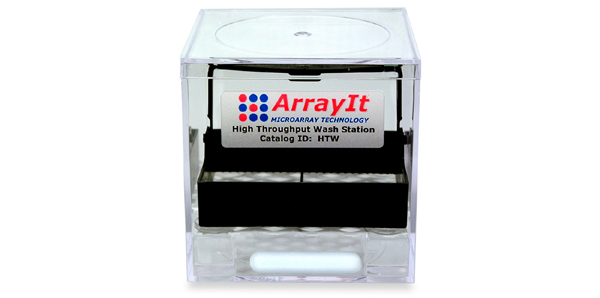
ArrayIt® has developed a highly innovative microarray wash station that facilitates microarray processing and washing at an affordable price. Our High-Throughput Wash Station accommodates 1-25 glass substrate slide microarrays in a durable slide rack that fits in a 500 ml buffer reservoir equipped with a magnetic stir bar. Compatible with all 25 x 76 mm glass microarrays, this wash station can be used with any magnetic stir plate and is essential equipment for all microarray laboratories. Multiple wash stations containing separate buffers speed microarray processing and washing.
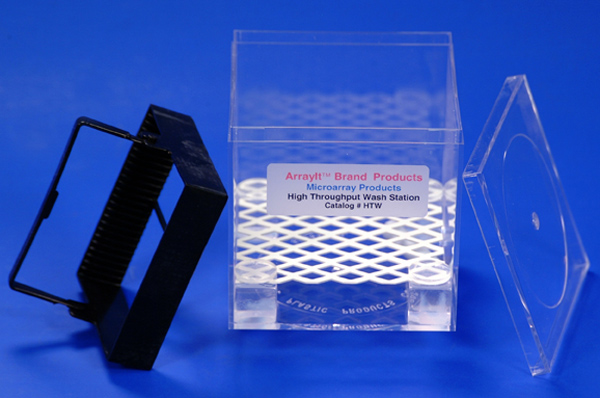
Figure 1. Shown are the components of the ArrayIt® High-Throughput Wash Station including the durable 25-position substrate slide holder (left), the 500 ml buffer reservoir with built-in stir bar (center) and the cover (right). Use in conjunction with any magnetic stir plate.
Table of Contents
- Introduction
- Quality Control
- Product Description
- Technical Assistance
- Short Protocols
- Complete Protocols
- Troubleshooting Tips
- Ordering Information
- Warranty
Introduction
Congratulations on taking a big step towards improving the affordability, quality and speed of your genomics, biomedical, pharmaceutical and agricultural research. This booklet contains all the information required to take full advantage of Arrayit's ArrayIt® Brand High-Throughput Wash Station.
Quality Control
Arrayit takes every measure to assure the quality of our ArrayIt® Brand High-Throughput Wash Stations. The finest microarray biochip research and engineering was used to develop this product. Rigorous quality control monitoring on a part-by-part basis guarantees that this product conforms to the highest industry standards.
Product Description
Arrayit's ArrayIt® Brand High-Throughput Wash Station provides the highest quality glass microarray wash station at an affordable price. All of our Wash Stations are designed by our team of world-class engineers and manufactured in our advanced microarray research laboratories by our trained technical staff. No other glass slide wash station on the market can compete with this product in terms of affordability or performance.
Users will appreciate the following features:
1. Holds 1-25 standard microarray substrates (25 mm x 76 mm)
2. Substrate rack stable to centrifugation (500 x g)
3. Can be used on any magnetic stir plate
4. Conserves buffer at 400 ml buffer per wash step
5. Room temperature washes with any aqueous buffer from 4-50°C
6. Acrylic box stable to mild solvents such as ethanol
7. Lid prevents buffer evaporation
8. Unique engineering design allows rapid buffer equilibration
9. Low cost allows multiple units to be used at once
10. Excellent for both nucleic acid and protein microarrays
Short Protocol
1. Fill the Wash Station with 400 ml buffer. For best results use ArrayIt Microarray Wash Buffers and Blocking Buffers.
2. Place the Wash Station on a magnetic stir plate.
3. Turn on the magnetic stir plate to initiate buffer mixing.
4. Place 1-25 glass microarrays in the black substrate rack.
5. Insert the rack into the Wash Station.
6. Cover the Wash Station with the tight-fitting lid.
7. Mix for 5 min with a wash buffer of choice.
8. Remove lid and substrate rack and empty buffer by inverting the Wash Station.
9. Add a new wash buffer and repeat steps 2-8 as the protocol requires.
10. When wash steps are complete, for best results dry using a microarray centrifuge.
Complete Protocol
1. Fill the Wash Station with 400 ml buffer. This volume will fill the Wash Station approximately 2/3 full. The Wash Station is designed to be used in aqueous (water-based) buffers, but the acrylic box is resistant to mild solvents such as ethanol and isopropanol. The use of strong solvents such as acetone will discolor the unit and should NOT be used under ANY CIRCUMSTANCES. For best results use ArrayIt Microarray Wash Buffers and Blocking Buffers.Microarray Buffers
2. Place the Wash Station on a magnetic stir plate. The unit should be placed in the center of the unit to avoid a “dancing” stir bar during the mixing process.
3. Turn on the magnetic stir plate to initiate buffer mixing. Choose a mixing speed that provides vigorous agitation without spilling the wash buffer over the top of the Wash Station. The Wash Station is designed for room temperature (20-25°C) washes, but can accommodate buffers pre-cooled to as low as 4°C or pre-heated to warm as 50°C. The Wash Station should NOT be used in freezers, on "hot plates" or in microwave ovens UNDER ANY CIRCUMSTANCES.
4. Place 1-25 glass microarrays in the black substrate rack. The black rack holds any “microscope slide” type substrate (25 mm x 76 mm).
5. Insert the rack into the Wash Station. Make sure the rack is in the center of the Wash Station for best mixing.
6. Cover the Wash Station with the tight-fitting lid. The lid prevents buffer evaporation during mixing and also keeps particulate from falling into the Wash Station during use.
7. Mix for 5 min with a wash buffer of choice. Buffers could include various dilutions of SSC, SSPE, SDS, TritonX-100, NP-40, ethanol, sodium borohydride or any other aqueous buffer that is used in conjunction with DNA or protein microarrays. The acrylic Wash Station is not stable to strong acids or bases or solvents such as acetone. DO NOT use improper buffers in this unit UNDER ANY CIRCUMSTANCES.
8. Remove lid and substrate rack and empty buffer by inverting the Wash Station. The retention screen will prevent the stir bar from falling out of the unit. Aqueous buffers can be discarded into a standard laboratory sink fitted with a proper drain.
9. Add a new wash buffer and repeat steps 2-8 as the protocol requires. This allows new buffers to be used for protocols that contain multiple wash steps. Several Wash Stations can be set up in tandem for increased throughput.
10. When wash steps are complete, for best results dry using a microarray centrifuge.
Troubleshooting Tips
1. No buffer mixing
- Check the stir plate power cord
- Make sure the mixing switch is turned on
2. Poor buffer mixing
- Make sure the Wash Station is in the center of the stir plate
- Check that the buffer volume is 400 ml
3. Uneven microarray signals
- Increase wash time
- Increase rate of buffer mixing
4. Buffer evaporation
- Make sure lid is closed
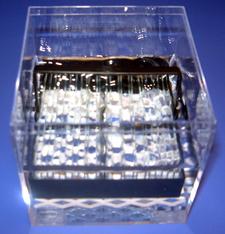
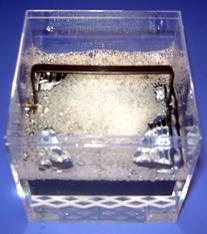
Figure 2. Wash Station in use. Shown is Arrayit's ArrayIt® Brand High-Throughput Wash Station with 25 glass substrates in the substrate rack and 400 ml buffer containing 1X SSC (left) or a protein microarray buffer containing detergent (right) in the Wash Station. The clear lid prevents buffer evaporation during use.
 |
Products - Microarray Tools - Microarray Wash Stations - High-Throughput Wash Stations to Speed and Simplify Blocking, Wash and Rinse Buffer Steps for DNA and Protein Microarrays
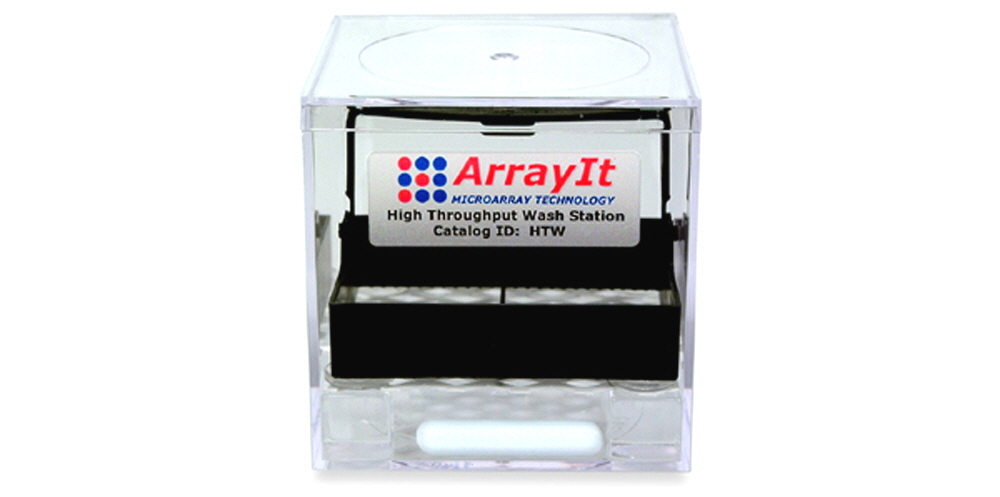
ArrayIt® has developed a highly innovative microarray wash station that facilitates microarray processing and washing at an affordable price. Our High-Throughput Wash Stations accommodate up to 25 microarrays in a durable slide rack and 500 ml buffer reservoir equipped with a magnetic stir bar. Compatible with all 25 x 76 mm glass substrate slide microarrays, these wash stations can be used with any magnetic stir plate and are essential equipment for all microarray laboratories. Multiple wash stations containing different buffers simplify and speed microarray processing and washing.
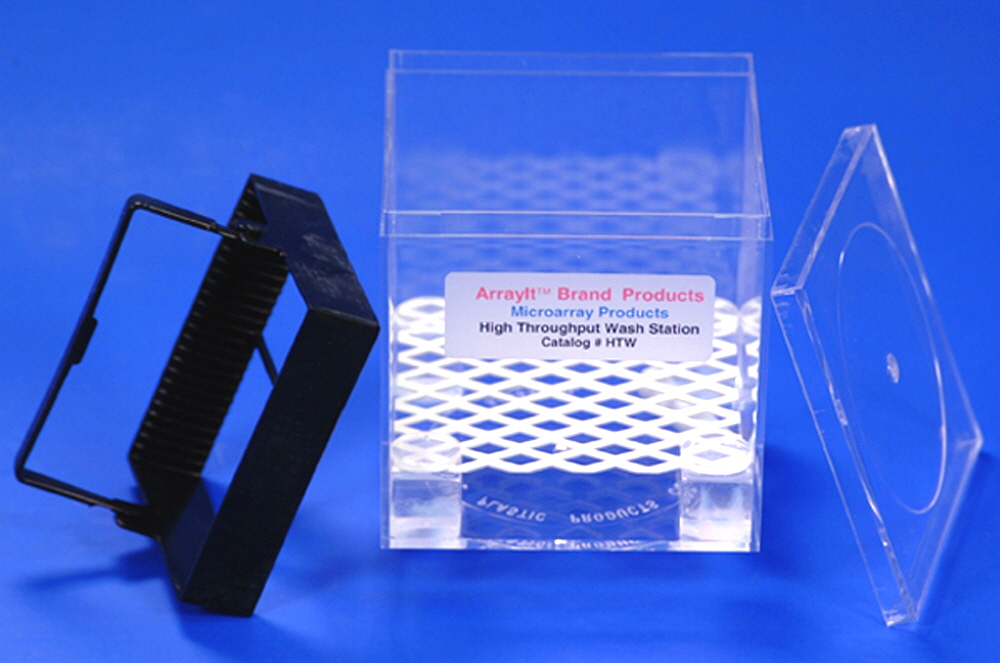
Figure 1. Shown are the components of the ArrayIt® High-Throughput Wash Station including the durable 25-position substrate slide holder (left), the 500 ml buffer reservoir with built-in stir bar (center) and the cover (right). Use in conjunction with any magnetic stir plate.
Table of Contents
- Introduction
- Quality Control
- Product Description
- Technical Assistance
- Short Protocols
- Complete Protocols
- Troubleshooting Tips
- Ordering Information
- Warranty
Introduction
Congratulations on taking a big step towards improving the affordability, quality and speed of your genomics, biomedical, pharmaceutical and agricultural research. This booklet contains all the information required to take full advantage of Arrayit's ArrayIt® Brand High-Throughput Wash Station.
Quality Control
Arrayit takes every measure to assure the quality of our ArrayIt® Brand High-Throughput Wash Stations. The finest microarray biochip research and engineering was used to develop this product. Rigorous quality control monitoring on a part-by-part basis guarantees that this product conforms to the highest industry standards.
Product Description
Arrayit's ArrayIt® Brand High-Throughput Wash Station provides the highest quality glass microarray wash station at an affordable price. All of our Wash Stations are designed by our team of world-class engineers and manufactured in our advanced microarray research laboratories by our trained technical staff. No other glass slide wash station on the market can compete with this product in terms of affordability or performance.
Users will appreciate the following features:
1. Holds 1-25 standard microarray substrates (25 mm x 76 mm)
2. Substrate rack stable to centrifugation (500 x g)
3. Can be used on any magnetic stir plate
4. Conserves buffer at 400 ml buffer per wash step
5. Room temperature washes with any aqueous buffer from 4-50°C
6. Acrylic box stable to mild solvents such as ethanol
7. Lid prevents buffer evaporation
8. Unique engineering design allows rapid buffer equilibration
9. Low cost allows multiple units to be used at once
10. Excellent for both nucleic acid and protein microarrays
Technical Assistance
Please contact us if you have any comments, suggestions, or if you need technical assistance. By electronic mail:arrayit@arrayit.com (under the subject heading please type "ArrayIt® technical assistance"). By telephone: (408) 744-1331, Monday–Friday PST 9:00am - 4:30pm. Please remember that we want to hear about your successes too!
Short Protocol
1. Fill the Wash Station with 400 ml buffer. For best results use ArrayIt Microarray Wash Buffers and Blocking Buffers.
2. Place the Wash Station on a magnetic stir plate.
3. Turn on the magnetic stir plate to initiate buffer mixing.
4. Place 1-25 glass microarrays in the black substrate rack.
5. Insert the rack into the Wash Station.
6. Cover the Wash Station with the tight-fitting lid.
7. Mix for 5 min with a wash buffer of choice.
8. Remove lid and substrate rack and empty buffer by inverting the Wash Station.
9. Add a new wash buffer and repeat steps 2-8 as the protocol requires.
10. When wash steps are complete, for best results dry using a microarray centrifuge.
Complete Protocol
1. Fill the Wash Station with 400 ml buffer. This volume will fill the Wash Station approximately 2/3 full. The Wash Station is designed to be used in aqueous (water-based) buffers, but the acrylic box is resistant to mild solvents such as ethanol and isopropanol. The use of strong solvents such as acetone will discolor the unit and should NOT be used under ANY CIRCUMSTANCES. For best results use ArrayIt Microarray Wash Buffers and Blocking Buffers.Microarray Buffers
2. Place the Wash Station on a magnetic stir plate. The unit should be placed in the center of the unit to avoid a “dancing” stir bar during the mixing process.
3. Turn on the magnetic stir plate to initiate buffer mixing. Choose a mixing speed that provides vigorous agitation without spilling the wash buffer over the top of the Wash Station. The Wash Station is designed for room temperature (20-25°C) washes, but can accommodate buffers pre-cooled to as low as 4°C or pre-heated to warm as 50°C. The Wash Station should NOT be used in freezers, on "hot plates" or in microwave ovens UNDER ANY CIRCUMSTANCES.
4. Place 1-25 glass microarrays in the black substrate rack. The black rack holds any “microscope slide” type substrate (25 mm x 76 mm).
5. Insert the rack into the Wash Station. Make sure the rack is in the center of the Wash Station for best mixing.
6. Cover the Wash Station with the tight-fitting lid. The lid prevents buffer evaporation during mixing and also keeps particulate from falling into the Wash Station during use.
7. Mix for 5 min with a wash buffer of choice. Buffers could include various dilutions of SSC, SSPE, SDS, TritonX-100, NP-40, ethanol, sodium borohydride or any other aqueous buffer that is used in conjunction with DNA or protein microarrays. The acrylic Wash Station is not stable to strong acids or bases or solvents such as acetone. DO NOT use improper buffers in this unit UNDER ANY CIRCUMSTANCES.
8. Remove lid and substrate rack and empty buffer by inverting the Wash Station. The retention screen will prevent the stir bar from falling out of the unit. Aqueous buffers can be discarded into a standard laboratory sink fitted with a proper drain.
9. Add a new wash buffer and repeat steps 2-8 as the protocol requires. This allows new buffers to be used for protocols that contain multiple wash steps. Several Wash Stations can be set up in tandem for increased throughput.
10. When wash steps are complete, for best results dry using a microarray centrifuge.
Troubleshooting Tips
1. No buffer mixing
- Check the stir plate power cord
- Make sure the mixing switch is turned on
2. Poor buffer mixing
- Make sure the Wash Station is in the center of the stir plate
- Check that the buffer volume is 400 ml
3. Uneven microarray signals
- Increase wash time
- Increase rate of buffer mixing
4. Buffer evaporation
- Make sure lid is closed
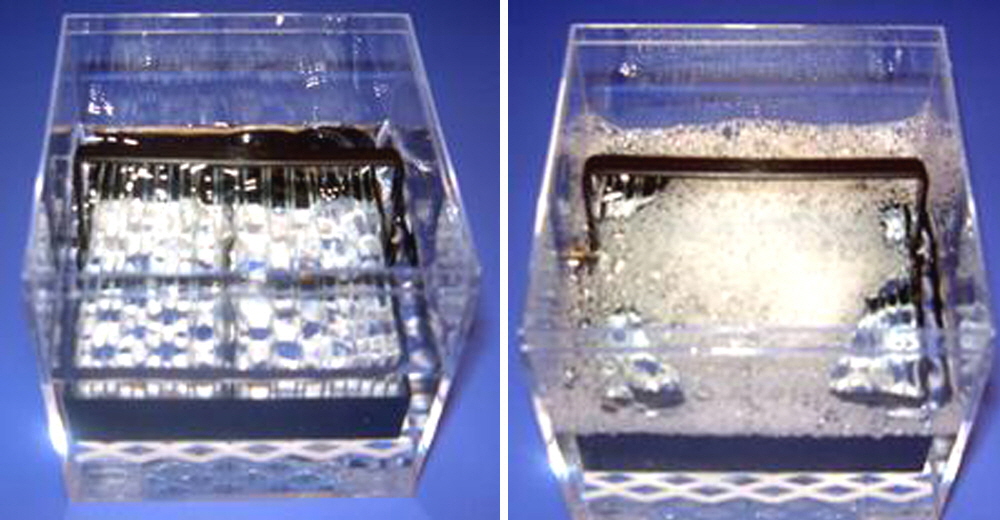
Figure 2. Wash Station in use. Shown is Arrayit's ArrayIt® Brand High-Throughput Wash Station with 25 glass substrates in the substrate rack and 400 ml buffer containing 1X SSC (left) or a protein microarray buffer containing detergent (right) in the Wash Station. The clear lid prevents buffer evaporation during use.
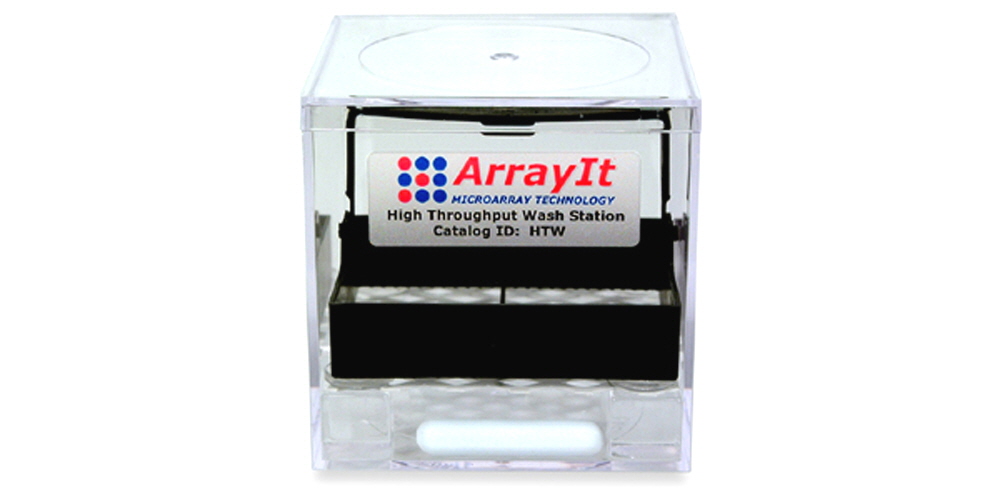
Figure 3. High-throughput wash station with 25-position glass substrate slide rack and built-in magnetic stir bar.

